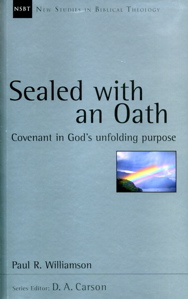Book Review: Sealed with an Oath
Williamson, Paul R. Sealed with an Oath: Covenant in God’s Unfolding Purpose. New Studies in Biblical Theology, Volume 23. Downers Grove, ILL: IVP Academic, 2007. Paperback, 224 pages. $23.00
(Review copy courtesy of InterVarsity Press.) Purchase: IVP | CBD | Amazon
Purchase: IVP | CBD | Amazon
Series: New Studies in Biblical Theology, Volume: 23
Series Editor: D. A. Carson
Special Features: Bibliography; Index of Modern Authors; Index of Scripture References
ISBNs: 0830826246 / 9780830826247
LCCN: BS680.C67 W55 DCN: 231.7/6
Subjects: Biblical Theology, Covenants
Paul R. Williamson is Lecturer in Old Testament and Hebrew at Moore Theological College, Sydney, Australia. He is the author of Abraham, Israel and the Nations and a contributor to The Land of Promise, the New Dictionary of Biblical Theology and volumes in the Dictionary of the Old Testament. (From back cover).
Sealed with an Oath: Covenant in God’s Unfolding Purpose is the twenty-third title in the New Studies in Biblical Theology series. In the context of this series, “biblical theology” refers, in Williamson’s words, to that framework in which “each concept, theme or book [of Scripture] is considered ultimately in terms of how it contributes to and advances the Bible’s meta-narrative, … a salvation history that progresses toward and culminates in Jesus Christ” (p. 17). The series is edited by D. A. Carson, and intends to explore “key issues in the discipline of biblical theology.” If this volume is representative, the series interacts with scholarly work while remaining accessible to the inquisitive lay reader.
Williamson’s goal in Sealed with an Oath is to “highlight the significance of covenant for biblical theology, and explore the role of this concept within God’s unfolding purpose” (p. 11). The author is helpfully forthcoming with his major departures from more widely held covenantal structures: specifically, Williamson holds to a dual Abrahamic covenant approach , and he views the Noahic covenant as the universal covenant, denying an Adamic covenant.
In the first chapter, Williamson traces the course of covenant (as theme or organizing principle) through history; from Cocceius through Witsius to the present day, including Wellhausen and other critics who claim covenant was a late development. Williamson is clearly aligned with Robertson, Dumbrell, and others who, though ignored in the mainstream critical debate, have very carefully and fruitfully treated the theme of covenant.
It is important to note here that the author does focus on the unity “of the various divine-human covenants … in terms of God’s eternal purpose” rather than focusing on an overarching “covenant of grace” (p. 31). This is not a book about “covenant theology” as that term is usually understood. Though, Williamson emphasizes the importance of covenant by asserting that “one cannot faithfully expound the Bible without paying particular attention to this important theological trajectory” (p. 33).
After reviewing covenant terminology, the author looks at the significance of covenant in Scripture and carefully examines the evidence for an Adamic covenant. Williamson bases his conclusion that there existed no divine-human covenant with Adam is based on “the lack of unambiguous textual warrant” (p. 58). Williamson concedes that the case for a postlapsarian Adamic covenant (see Robertson) may seem stronger, but again objects based on God’s directing this promise to the serpent rather than to Adam and Eve.
Moving to the Noahic covenant, foundational in Williamson’s view, context is emphasized. The author ties the covenant to God’s revelation, arguing for a Genesis 9 rather than Genesis 6 ratification. Williamson also takes care to highlight the universal nature of the Noahic covenant, and he details references in the prophetic books to God’s universal covenant. In addition to its universal scope, this covenant is theologically significant as “it is the basis for our present confidence in God as Sustainer” (p. 67). Williamson concludes the chapter by outlining and criticizing the “covenant with creation” advanced by Dumbrell and others. Instead, he concludes, of “allowing creation to be subsumed under covenant, covenant must be understood in the context of creation,” a distinction of importance to our understanding of redemptive history (p. 76).
Williamson approaches the patriarchal covenants, and all others, in the framework of the Noahic covenant because it was never abrogated. Examining the pivotal text of Genesis 12:1-3, the author finds a two-fold agenda; the first section treats Abraham as the recipient of blessing while the prospect of national status is held out. In the second, Abraham is the mediator of blessing, and that blessing is international in scope. So, when looking at Genesis chapters 15 and 17, the author concludes that there were two divine-human covenants between God and Abraham. The first covenant is unilateral, temporal and narrower in focus than is the second. In Genesis 17, the covenant with Abraham is both national and international in scope, with bilateral obligations, and eternal in length.
While God’s national covenant with Israel is the most prominent of divine-human covenants, the author insists that it does not supersede the patriarchal covenant. Williamson advocates a bilateral understanding of the national covenant and points to the Decalogue as the primary source of Israel’s covenant obligations. These obligations reveal truth about the natures of the parties to the covenant. This covenant was ratified at Sinai, and the Sabbath is its sign. Williamson also details the breaking, reestablishment, and multiple renewals of this covenant.
Although some covenant elements are missing, the author also finds a divine-human covenant with David. Hesed, sometimes a synonym for berit, provides the linguistic support for this position. Williamson terms this a royal covenant and focuses on the dynastic oracle, perhaps best imagined in the houses God and David’s dynasty will build for each other. In this oracle is a slight shift in covenant scope from national to royal.
The final three chapters of the book focus on the new covenant; as anticipated by the prophets, as inaugurated through Jesus, and as consummated in the eschatological kingdom. Jeremiah offers the clearest discussion of new covenant among the prophets, and Williamson examines Jeremiah 31 in some detail and in context of its use by the author of Hebrews. After looking more briefly at other anticipations of and possible allusions to the new covenant in the prophets, Williamson draws the following conclusions about the new covenant from the prophetic testimony: the new covenant will be both national and international, it will involve both continuity and discontinuity, and it will be both climactic and eternal.
In the New Testament, we look at explicit uses of diatheke. In the Gospels, we look almost exclusively at the new covenant in the context of the Last Supper, and in Acts we look at the inclusion of Gentiles in the new covenant. In the Pauline epistles, Williamson rejects the New Perspective and Sanders’ covenantal nomism before arguing for a replacement theology (though not a supersessionist replacement) over a two covenant approach. The author, echoing and improving upon Hahn, also reads testament in Galatians 3 as covenant rather than legal instrument. Because Hebrews offers the fullest treatment of the new covenant, Williamson moves through the text, carefully dealing further with supersessionism and, in Hebrews 9, again arguing against a legal instrument reading of testament with a slight variation on Hahn.
The final chapter, on the consummation of the new covenant in the eschatological kingdom, fills fewer than three pages. This reminder that we live in the “already, but not yet” segment of new covenant fulfillment would feel tacked-on but for the triumphant nature of this truth. Williamson closes with these words:
Thus while the new covenant is fulfilled in the person and work of Jesus Christ, the ultimate eschatological reality awaits the “new heavens and the new earth, where righteousness is at home” (2 Pet. 3:13 NRSV)… . Then and only then—in that eschatological reality, the New Jerusalem—will the hope expressed in the age-old covenant formula be most fully experienced: “God’s dwelling place is now among the people, and he will dwell with them. They will be his people, and God himself will be with them and be their God” (Rev. 21:3 TNIV). However long it may be before this eschatological goal is finally realized, the absolute certainty of this great Christian hope can never be in doubt. Our assurance stems from the fact that God has not only spoken his word of promise, but has also sealed it with an oath. (p. 210)
While other books undoubtedly offer a more approachable introduction to covenant in biblical theology, Sealed with an Oath is a helpful addition. This book will particularly benefit pastors teaching and seminary students studying divine-human covenants. Laypersons interested in learning more after reading Robertson or Dumbrell will find much complementary material in Williamson’s excellent book.
 J.A. Ingold lives with his wife in Washington, DC. He earned his B.S. from Bob Jones University (Greenville, SC) and his J.D. from The George Washington University School of Law. He has been a member of the Capitol Hill Baptist Church since 2003. The opinions expressed in this review are his alone and should not be attributed to SharperIron or to Capitol Hill Baptist Church. J.A. Ingold lives with his wife in Washington, DC. He earned his B.S. from Bob Jones University (Greenville, SC) and his J.D. from The George Washington University School of Law. He has been a member of the Capitol Hill Baptist Church since 2003. The opinions expressed in this review are his alone and should not be attributed to SharperIron or to Capitol Hill Baptist Church. |
Click here to learn more about SharperIron book reviews.
- 52 views


Discussion